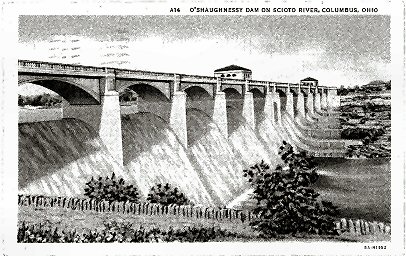Historical Info for Water Supply & Source Management
"Columbus is in the heart of an area that abounds in small streams. By the building of judiciously located dams and storage reservoirs, it has been estimated that these streams could be developed into a water supply system sufficient ...for 2,500,000 people."
- Charles Hoover, chief chemist, 1949
 In the 1870s the City of Columbus was a state capital nestled between the banks of the Scioto and Olentangy Rivers. As with most thriving communities of those times, the availability of water played a crucial role in the growth and prosperity of Columbus.
In the 1870s the City of Columbus was a state capital nestled between the banks of the Scioto and Olentangy Rivers. As with most thriving communities of those times, the availability of water played a crucial role in the growth and prosperity of Columbus.
In 1904, the city began construction of a dam on the Scioto River just north of Columbus to provide for an adequate water supply. Julian Griggs, the City's chief engineer used a plan developed by Samuel Gray, an engineer from Providence, Rhode Island. The City hired John Gregory, a consulting engineer from New York, to coordinate the building of the dam. The dedication of the dam was in 1908.
First Photo - Griggs Reservoir October 31, 1906. Second Photo - O'Shaughnessy Postcard 1937.
 Jerry O'Shaughnessy began his career with the City of Columbus in 1870 as a ditchdigger, digging the foundation for what was to become the new Columbus Waterworks. Following the 1913 Flood, O'Shaughnessy, then superintendent of Waterworks, fought efforts to add to the height of the Griggs Dam by urging the city to build an additional storage dam further north on the Scioto River, a more feasible solution. Unfortunately, Mr. O'Shaughnessy did not live to see completion of what was then said to be the "best inland city reservoir and dam in the United States." When O'Shaughnessy Dam was completed in 1925, Columbus had a water supply to serve a population of one half million - twice the city's size at the time.
Jerry O'Shaughnessy began his career with the City of Columbus in 1870 as a ditchdigger, digging the foundation for what was to become the new Columbus Waterworks. Following the 1913 Flood, O'Shaughnessy, then superintendent of Waterworks, fought efforts to add to the height of the Griggs Dam by urging the city to build an additional storage dam further north on the Scioto River, a more feasible solution. Unfortunately, Mr. O'Shaughnessy did not live to see completion of what was then said to be the "best inland city reservoir and dam in the United States." When O'Shaughnessy Dam was completed in 1925, Columbus had a water supply to serve a population of one half million - twice the city's size at the time.
In 1945, much to the surprise of our city planners, Columbus was nearing the limits of its water supply. Post World War II growth of population had increased demand for water equal to a normal 15 year period; and in January 1945, the watershed froze for three and one half months producing the longest drought Columbus had ever known. This prompted plans for a dam on the Big Walnut Creek. In September 1955, the dam was dedicated "Hoover Dam" in memory of brothers, Charles and Clarence Hoover, who both served the City of Columbus Waterworks.
In the late 1960s it became apparent that an additional water supply would be needed. A study of southern Franklin county found a large underground water supply between the Scioto River and Big Walnut Creek. Construction began on four large Ranney Collector Wells that ranged from 68 to 109 feet deep with laterals totaling more than 6,000 feet reaching into the aquifer. These wells supply an average of 20 million gallons of water daily to residents in southern Franklin County.
Today, the three reservoirs provide 90% of the more than 140 million gallons used daily. The remaining 10% is drawn from the wells in southern Franklin County.
The Scioto River begins as a small creek about 80 miles north in Hardin County, northwest of Kenton, Ohio. Rolling through woods and farmlands, this river remains a main water source for Columbus. The Griggs and O'Shaugnessy Reservoirs, located on the Scioto River, have a combined storage capacity of 6.2 billion gallons, holding only a small percentage of the water that flows through Columbus, and providing water for downtown, west and northwest Franklin County. Family picnics, fishing, boating, and waterskiing in the recreation area surrounding and including both reservoirs are enjoyed by thousands every summer.
Big Walnut Creek forms about 20 miles northeast of Columbus and feeds Hoover Reservoir. This reservoir can hold 20.8 billion gallons of water; it supplies water for the entire northeast portion of Franklin County and provides a beautiful recreation area for boating and fishing.
The rest of the world is recognizing something that our leaders in Columbus have known for decades, the most important part of the water treatment process is protection of our water sources. The Division resumed responsibility and management of the reservoirs in 1994. Our Watershed Management Team is responsible for overseeing the land management, boat safety, and public education regarding protection of drinking water sources. In 1996, the Ohio Environmental Protection Agency (OEPA) approved the Wellfield Protection Plan we developed.